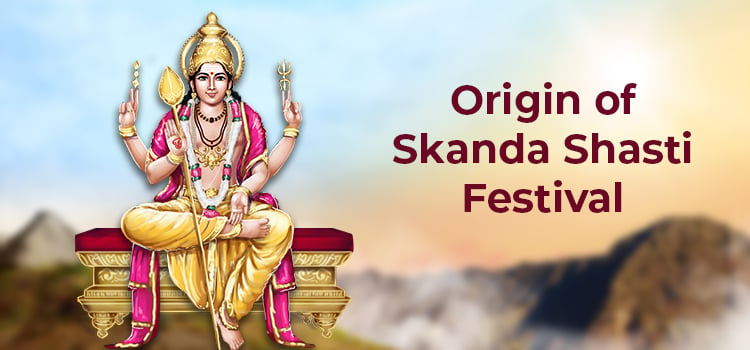Origin of Skanda Shasti Festival
Skanda Sashti is a festival that is dedicated to Lord Muruga. It is on the sixth day of Shukla Paksha, or the bright fortnight of Aippasi month (October – November). Muruga is the second son of Lord Shiva and Goddess Parvati. He is also known as Kumaran, Guha, Shanmukha, Kartikeyan, Velayudhan, etc. The story goes that Muruga killed the demon, Soorapadman, as well as his brothers, Taraka and Simhamukha, on this day. These demons were causing a lot of problems for the gods and humans alike. All Shaivite and Muruga temples in South India celebrate the festival, as Lord Muruga is the patron deity of Tamils.


Skanda, the Deity
Skanda is a deity who has been worshipped since ancient times. Stone inscriptions of the past mention him, and his images can be seen on coins (1st cent. to 5th cent CE). Texts like the Mahabharatha, Shiva Purana, etc., tell the story of Muruga. The poet, Kalidasa, has retold the story in his work, Kumara Sambhavam. Chandogya Upanishad refers to Skanda as Sanat Kumara. Arunagiri’s Thiruppugazh, Nakkeerar’s Thiru Murugatrupadai, and many other Tamil texts have sung praises of Lord Muruga. Skanda Sashti festival celebrates the victory of good over evil, like many Hindu festivals. Skanda Purana talks about the origin of Kandha Sashti Viratham or fasting during Skanda Sashti. As per the Skanda Purana, which is the longest of the 18 Mahapuranas, Soorapadman, Simhamukha, and Tarakasura and their army of demons defeated the Gods and also conquered the earth. They began to harass the Gods and humans with impunity. The Gods were at their wits’ end as Soorapadman was invincible. Only a son born to Lord Shiva could kill him, according to a boon he had received. The demon knew that Shiva was in deep meditation after his wife, Sati, died. He felt that Shiva would not get over her death or get married. So he was sure that there would be no threat to his life from any son born to Shiva, as the latter was a widower, and neither was he likely to take another wife in the near future due to his intense grief over Sati’s loss. The demigods or Devas ran to Shiva, but Shiva did not emerge from his meditation. Lord Brahma had an idea. Why not ask Kamadeva, the God of Love to disturb Shiva’s meditation and awaken sexual desire in him? Meanwhile, Sati had been reborn as Parvati, the daughter of Himavat, and she was doing severe penance to reunite with Shiva as his wife. Kamadeva was able to awaken Shiva, but he lost his own life in the process, as a furious Shiva opened his 3rd eye and reduced him to ashes. However, nobody could tolerate the heat of Shiva’s seed. It fell into Agni’s mouth and was carried by Vayu to the Ganges, who in turn deposited it in Sara Vana (a forest of arrow-like grass). In this manner, Saravanabava (Muruga) was born. He got the name Skanda as he symbolized Shiva’s power of chastity which was preserved through penance. The six Krithikai maidens (Pleiades) raised Skanda. There were actually 6 babies from the 6 sparks of fire that emanated from Shiva. Goddess Parvati embraced all the six babies who merged to become one baby with six faces and one body. This earned him the name, Shanmukha. As Shanmukha grew up, he became Kumara, the powerful and handsome youth. The Gods made him the Senapathi/Commander of their army. General. His mother, Parasakthi, gave him a divine and powerful Vel (lance). Muruga then fought the armies of Simhamukha, Soorapadman, and Tarakasura for 6 days and killed all of them on the sixth day, liberating the Devas from the tyranny of the demons/Asuras. Finally, Muruga killed Soorapadman with his ‘Vel.’ This is called Soorasamharam. The 6th day (Sashti) of the waxing moon (Shukla) in Ashada month (Oct/Nov) is celebrated as Skanda Sashti. Devotees chant ‘Vetrivel’ on Shasti day to commemorate Skanda’s victory over Soorapadman. Indra got back heaven, and he also gave his daughter Deivayanai/ Devasena in marriage to Skanda.Skanda Sashti Viratham
Devotees observe a fast during the 6 days of the festival. It is called Skanda Sashti Viratham or Kandha Sashti Viratham. It can be a complete fast or a partial one. It is the custom to follow some basic rules when observing the fast. They are given below.- Avoid non-vegetarian food completely.
- Some avoid garlic and onions, too.
- Read sacred texts on Lord Muruga and recite the Skanda Sashti Kavasam or Subramanya Bhujangam.
- Visit Muruga temples during the period.
- Take one meal a day. It can be had at noon or night.
- Take fruits and juices on all 6 days.
Skanda Shasti Benefits
By observing Kandha Sashti Viratham, one can get many blessings and benefits.- It can help childless women to conceive.
- It can resolve marital discord.
- It bestows good health.
- It brings abundant blessings from Lord Muruga for peace and prosperity.






